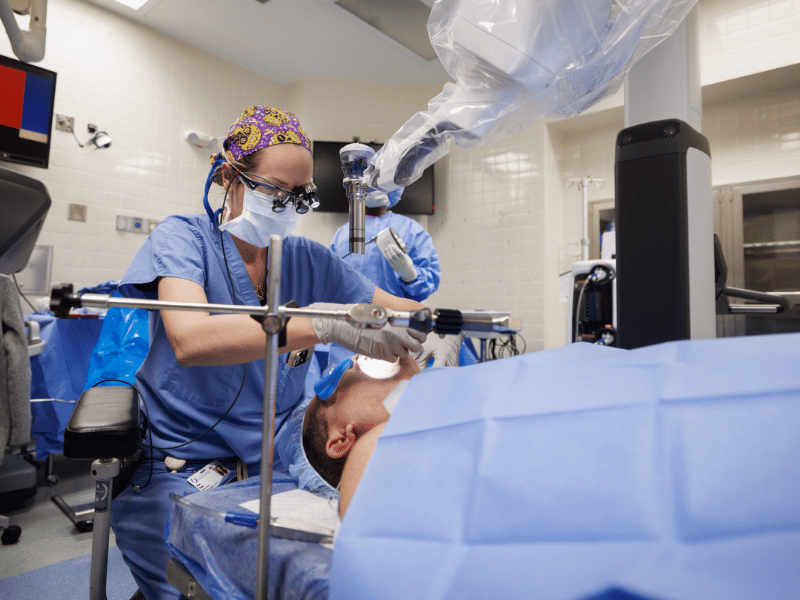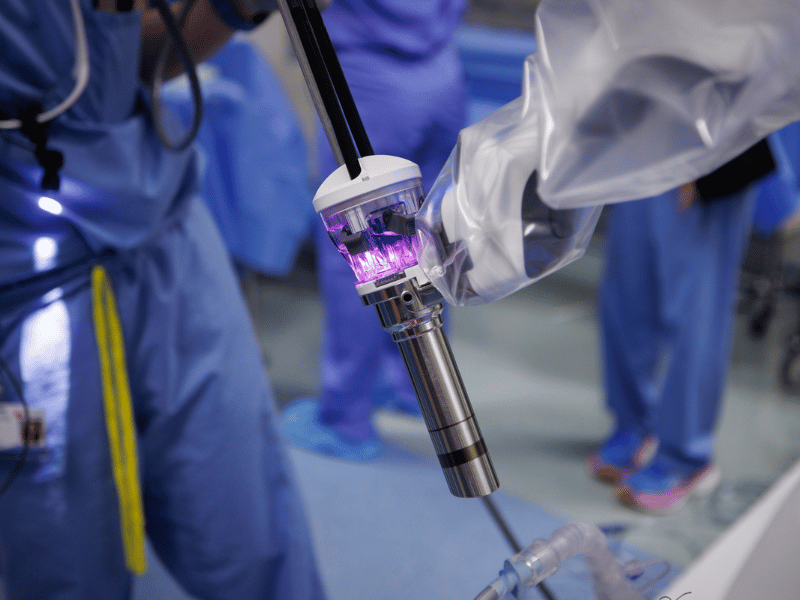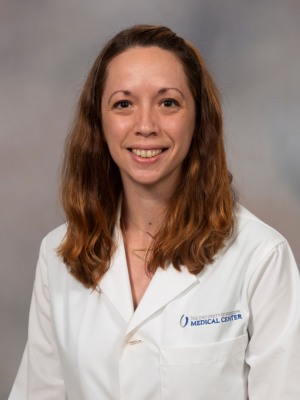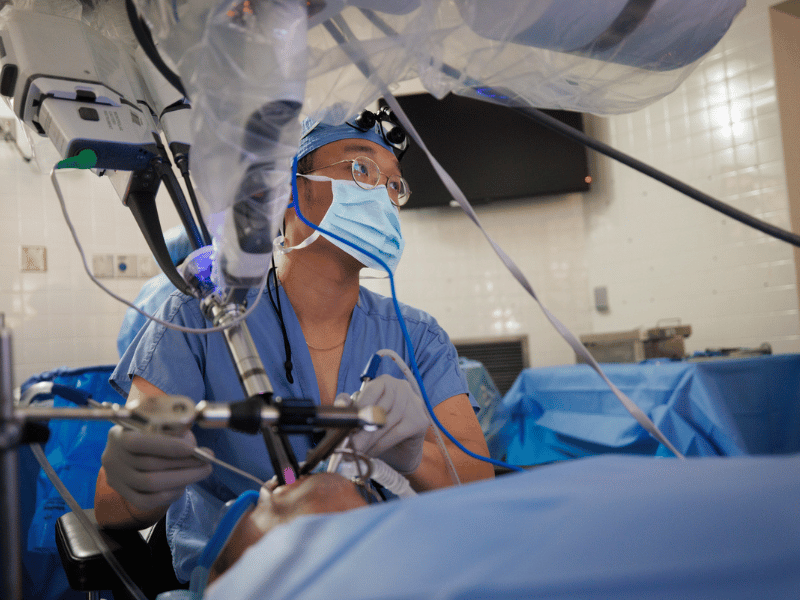UMMC surgeons conduct the first single port robot-assisted surgeries in the state

The University of Mississippi Medical Center is the first institution in the state to offer patients operations assisted by the new Da Vinci SP surgical system. The addition of this state-of-the-art technology will provide patients with improved surgical outcomes, shorter recovery periods and better cosmetic results, according to UMMC surgeons.
It will also increase procedure capability in the thriving robotics program at UMMC, allowing better and quicker access to more Mississippians needing surgery.

“The outcomes for the surgeries I have done have been very promising and based on urological experts in the field, SP surgical outcomes tend to be similar or even better than when performed with the multiport robot.” said Dr. Paula Domino, reconstructive urology surgeon and the first in the state to operate using the Da Vinci SP. “The cosmetic results for the patients are excellent with a one-inch incision size, and there is less of a need to prescribe narcotics. Patients can be discharged earlier, if not the same day, and recover at home.”
Patient Faith High of Brandon saw Domino for a ureteropelvic junction obstruction, a blockage in the tube (ureter) that carries urine from the kidney to the bladder, which can cause pain, infection and kidney damage if not treated. High said Domino presented her with the options for her surgery—the multiport system which would take a few smaller incisions in her abdomen or the single port system which would make only one, slightly longer incision near her bikini line. The patient opted for the latter, noting that the incision site is “easy to hide”, leaving behind only one small scar, “about the length of her pinky,” Domino said.
Currently in the United States, the Da Vinci SP system is approved for single-port urological procedures, lateral oropharyngectomy procedures (commonly known as radical tonsillectomy) and tongue base resection. This cutting-edge, single-port robot is designed for precision surgical assistance with minimal invasiveness, specifically tailored for intricate procedures in confined and deep spaces. The streamlined design provides a 360-degree range of anatomical access, and the single arm eliminates the possibility of external collisions.

The Da Vinci system translates the surgeon's hand movements at the console in real-time, manipulating and adjusting the instruments during the procedure. These tiny, wristed instruments mimic human hand movements but with an expanded range of motion. An endoscope allows surgeons to view an area at all angles during an operation with the aid of an enhanced three-dimensional, high-definition resolution. This gives surgeons a clear, crisp, and highly magnified view of the surgical area, and the instrument's small size enables surgeons to operate through one or a few small incisions.
The UMMC Department Otolaryngology – Head and Neck Surgery including Dr. Anne Kane, surgeon and head and neck cancer specialist, and Dr. Scott Stringer, chair of otolaryngology, were instrumental in bringing this new technology to the state, with the support of Dr. Mildred Ridgway, gynecologic oncologist and chair of the UMMC Robotics Committee. This is part of the strong commitment of health system leadership to providing state of the art robotics technology to benefit those in need of these services in the state of Mississippi.
With rising numbers of oropharynx cancer across the nation, specialists are grappling with how to most effectively treat patients.

“One of the things that our field has been doing for the past 10 to 15 years is trying to find new ways to treat these cancers,” Kane said. “HPV-related oropharynx cancers are a distinct entity within head and neck cancer. These are typically younger patients, who are non-smokers and without common risk factors associated with throat cancer.”
Overall, the lifetime risk of developing oral and oropharyngeal cancer is about 1 in 60 for men and 1 in 141 for women. However, cancers in the oropharynx linked with human papillomavirus (HPV) infection increased yearly by 1.3% in women and by 2.8% in men from 2009 to 2020. The American Cancer Society estimated that about 54,500 new cases of oropharyngeal cancer would be detected in 2023, approximately 80% of which are typically associated with HPV.
Although HPV-linked oropharyngeal cancer has increased over the past decade, exceeding the number of cases of HPV-related cervical cancer, these cases tend to have better prognoses compared to head and neck cancers not linked to HPV.
Recent studies have demonstrated that TransOral Robotic Surgery, minimally invasive robotic surgery techniques that enable surgeons to remove benign and malignant tumors of the mouth and throat, surpasses previous methods in identifying primary sites. TORS has also proven effective in de-escalating post-surgery treatment with radiation and chemotherapy, often decreasing and/or eliminating additional therapy. Low-risk cases can be managed with surgery alone, while in intermediate and high-risk cases, TORS can reduce the dosage of radiation treatment and often eliminate the need for chemotherapy entirely.
“When trying to identify a primary tumor in the past, we would use a scope and biopsy different areas of the mouth and throat, yielding about a 40% success rate,” said Kane. “With robotic-assisted surgery, the identification rate has risen to about 70%. In the right candidate, TORS gives us the opportunity for decreased long-term side effects of treatment while still appropriately treating the cancer. This has really given us a lot of capability when it comes to caring for our patients in Mississippi.”

For patients like Todd Wilson of Madison, this is a game-changer. Wilson was diagnosed with malignant HPV-related squamous cell carcinoma after his dental hygienist, School of Dentistry alumna Brett Quon, discovered an unusual lump on his neck during a routine oral cancer screening. After a PET/CT scan, the only traceable location of the cancer seemed to be his right neck lymph nodes.
Since any foreign substances such as cancer cells would pass through the lymphatic system, they would be visible in the lymph nodes regardless of their primary source. This advanced technology will better assist in the identification of the cancer’s source, minimizing a lot of guess work for surgeons and oncologists.
The highly skilled surgeons at UMMC, the only hospital in the state with TORS certified ENT surgeons, all share a focus on expanding services to include the most complex, high-level surgical care available in Mississippi. The department has conducted over 70 robot-assisted surgeries over the past several years, using predecessors to its most recent acquisition: The first generation Da Vinci SI and third generation Da Vinci XI multiport systems.
Kane said that when she joined UMMC in 2020, they were doing approximately one robotic-assisted surgery per month, conducting about 10 in her first year. As the robotics practice continues to expand, she said they are now doing about two to four per month.
For urologic specialists like Domino, this advancement means offering patients another minimally invasive option, particularly beneficial for complex urinary tract reconstruction.
“Urologists have been leaders in surgical technology advancements through the years with robotic surgery as an essential part in treating different reconstructive and oncologic pathologies,” Domino said. “The single port robotic system is now another minimally invasive option in our armamentarium for our patients with the goal of maximizing surgical and cosmetic outcomes, while minimizing post-operative pain and recovery time”.
With their newest robotic technology, the UMMC surgical teams hope to facilitate more positive outcomes for patients and provide procedures for more Mississippians requiring oropharyngeal or urological surgery.


